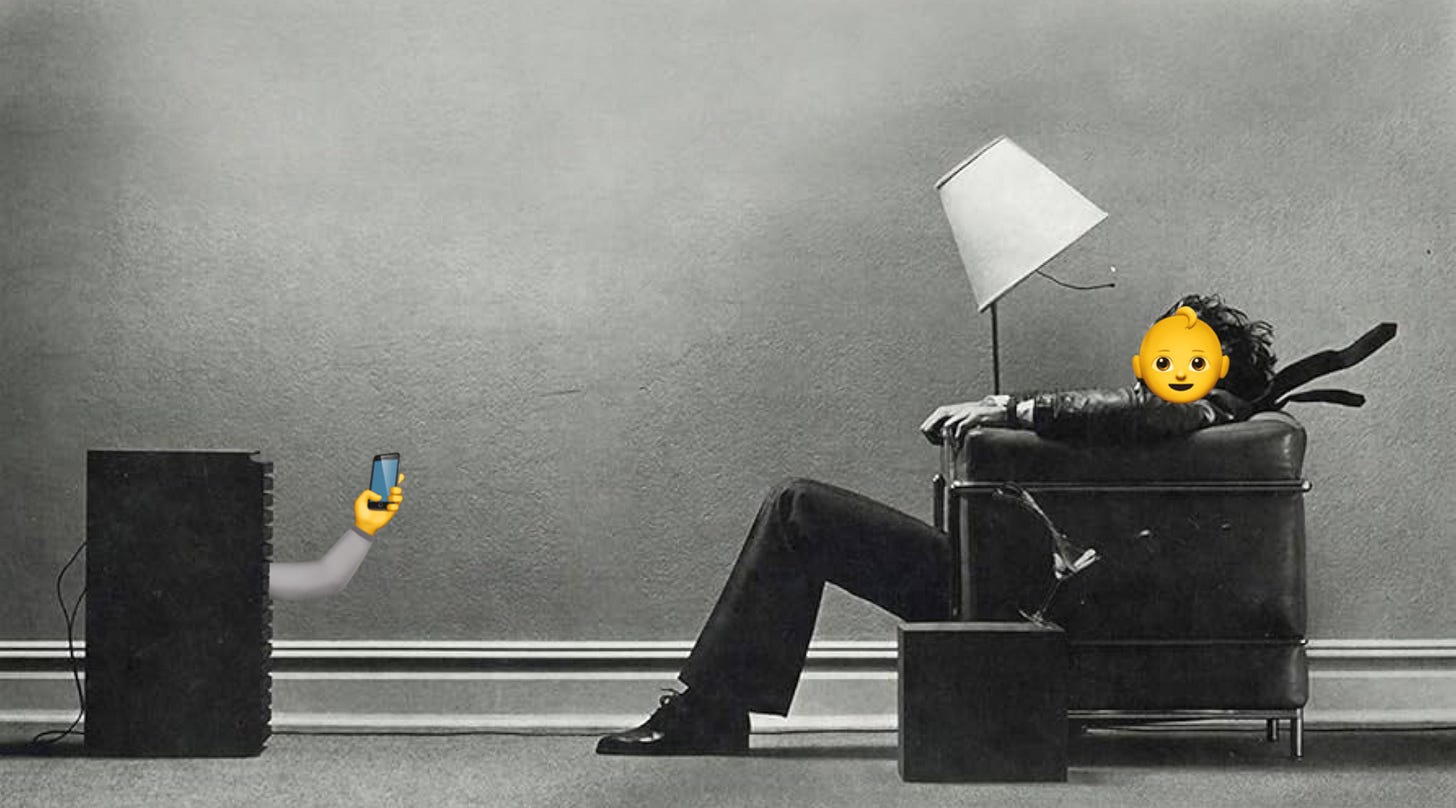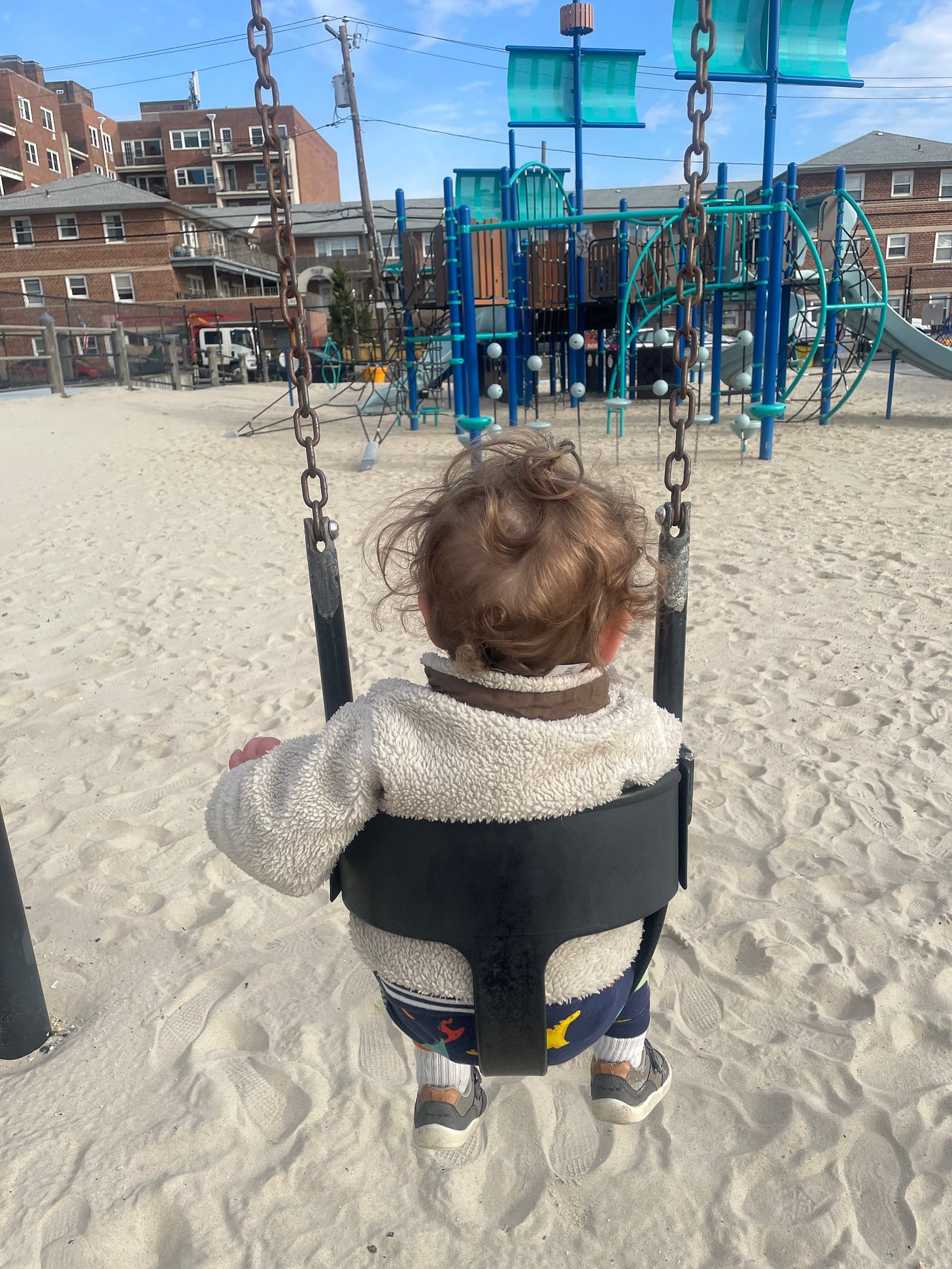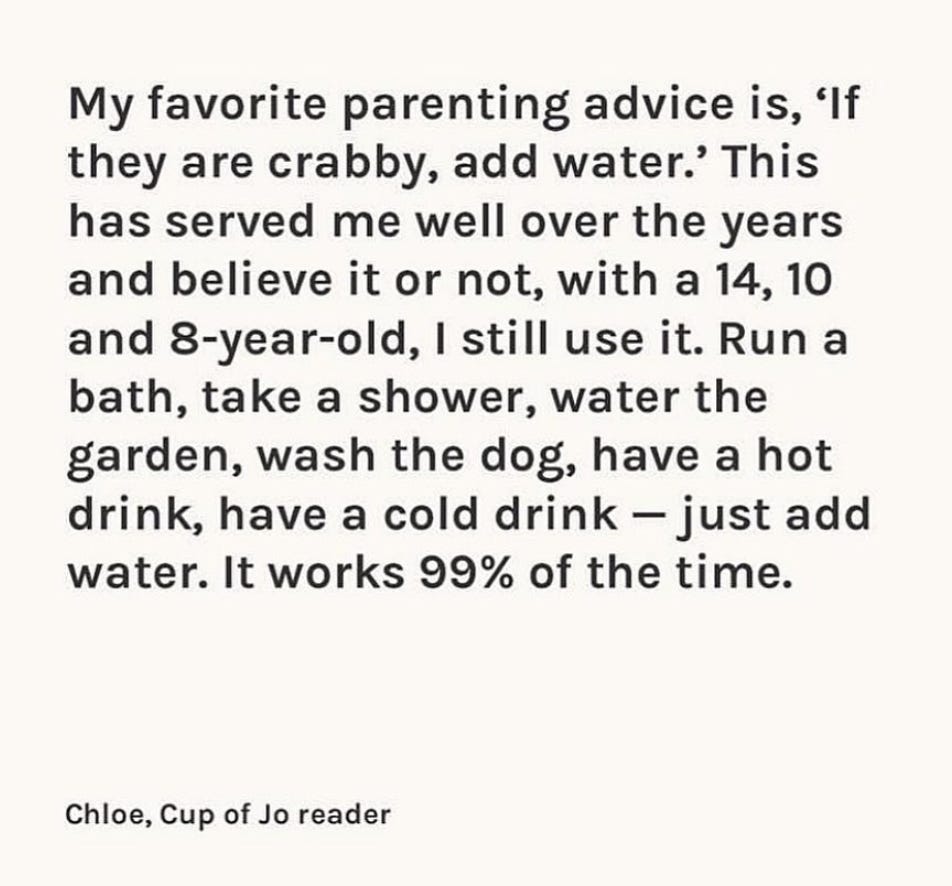How To Not Give Your Baby or Toddler A Smartphone
10+ expert, practical, real-life tips to keep kids calm, happy, and engaged—sans screens. Based on child development and years of hands-on experience, I got you!
Hi everyone, I’m so happy you’re here!
In February 2025, Common Sense Media released new research that examines digital media habits for children age 8 and under.
The report finds that 40% of children have a tablet by age 2, and their screen time averages at about 2.5 hours per day.
I gotta be honest—this is the article I’ve been dying to write but also totally dreading, because it stirs up all my shit—tech, family, and young kids.
I also hate telling people what to do.
Plus, I know I’m far from perfect, and I would rather jump out of a window than be perceived as hypocritically preachy or something!
But BUT! I just gotta say some things…
I get why the phone feels like an easy fix when your kid is inconsolable, wildly fussy, or you just need a minute.
I know it works. Of course it does!
It’s so instantaneous, so easy for you, and so mesmerizing for them. A little phone play here, a quick YouTube video there, a peek at the camera—it seems harmless.
But the research is clear: it’s not!
Phones and tablets don’t make kids calm or happy. They simply stun and overwhelm them into a daze. It looks like engagement, but it’s more like they’re in a trance.
And that is really, really bad for their developing brains.
Plus, those few minutes here and there add up.
Before you know it, it’s the default for every fuss, fidget, or tricky moment.
Before you know it, they’ve crept into every part of your child’s day—diaper changes, mealtimes, bedtime, car rides, stroller walks, grocery stores, restaurants.
I’ve seen it happen with countless kids and families now.
Yes, it may buy you a few minutes of peace. But it’s costing you and your child so much more.
The good news is that with just a little insight into how babies and toddlers operate, you can hold off on ever giving them your phone—or at least cut way back!
There are so many ways to tune into your little one—ways that help them feel happy, calm, and engaged without a screen.
I promise! I got you!
Who am I?
Hi, I’m Danielle! I’m an Early Childhood Educator with over a decade of experience working in progressive, play-based preschools across Brooklyn, including some lovely Reggio Emilia and Montessori schools.
The age-2-and-under set are my absolute favorite and are my area of expertise, if I may say so myself!
I have a Master’s degree in Early Childhood Ed, and certifications in Newborn Care and Kids’ Yoga and Mindfulness.
But really, I’m just someone who’s spent years working closely with babies, toddlers, and their families, plus wrangling my own two boys.
I’ve learned how babies and toddlers work—how to hold their attention, when to let them be, how to shift a mood, how to buy yourself a little breathing room, all without defaulting to a screen.
And I want to share what I know.
Not to shame, nor to scold. Just to make things easier for everyone.
I want everyone to have a few tricks in their pocket for the hard times, because I honestly get it—kids are weird and tricky and don’t give you a second to think sometimes!
And once you start handing them your phone (or just letting them take it), it’s really hard to stop.
Why Specifically No Smartphones & Tablets:
In our screen-saturated world, not all screens are equal. This isn’t about family movie nights or the occasional, age-appropriate TV show.
I’m talking about portable, touch-screen devices like smartphones and tablets—and more specifically, about using them as a default pacifier.
The research is clear: these devices are reshaping the way all of us—adults, teens, kids, toddlers, babies—think, feel, and interact. No one is spared.
If we want something different for the next generation, we have to make a conscious choice to break the cycle.
To give our babies and toddlers a real chance at existing in this loud, distracting, overwhelming world without a screen between them and real life.
These devices are designed to deliver rapid-fire dopamine hits through instant touch-response, bright colors, and endless, auto-playing content.
For babies and toddlers, this constant stimulation rewires the brain’s reward system, making real-world experiences—looking at a book, playing outside, or engaging with a caregiver—feel slow, boring, or unsatisfying in comparison.
How heartbreaking is that?!
On top of that, smartphones and tablets disrupt emotional attunement, the back-and-forth rhythm of connection between a caregiver and child that builds emotional security and communication skills. When a screen is in the mix, both parent and child miss out on countless micro-moments of eye contact, shared expressions, and co-regulation—those tiny but crucial exchanges that form the foundation of deep emotional bonds.
And here’s the kicker: Kids very quickly learn to crave the screen. Then they need the screen.
Soon, it’s the only thing that will make them stop crying.
Instead of learning how to regulate their emotions, their nervous system becomes dependent on a device that is way too powerful for their little brains to handle.
This is why smartphones and tablets should be introduced much, much later, and only in moderation—not as a go-to soothing tool.
Protecting their early years from these devices is one of the greatest gifts you can give them.
But Also: Be Realistic and Flexible
This is how I (try to) stay sane in this world: these are my boundaries, and I hold them as best as I can—but I also know that other people have different ways of doing things.
Grandparents might show them a cute YouTube video. A well-meaning neighbor might hand them their phone when they’re upset. Screens may be present and active at other people’s homes, restaurants, play dates, daycares, schools.
And, I mean, it’s definitely not my first choice, but it is what is is? Kinda? You know??
We live in such a screen-saturated world that total restriction isn’t always realistic—and in some cases, it can backfire, creating a sense of scarcity, secrecy, and an obsession around screens in the kids as they grow.
I don’t want that for my kids, either!
In our house, my phone is completely off-limits. I treat it like a hot stove or a sharp knife—always a no-go, even still for my seven-year-old. He doesn’t have regular access to a tablet, and he has never used one at a restaurant or in the car.
However!, we are also currently in a full-family-TV-reset because we had recently gone so far off the rails with how much we were all watching, so believe me, there is no judgement here. I know just how slippery the slope is!
But when it comes to phones and tablets, we keep the line very clear: those devices are not for young kids.
At its core, my screen philosophy comes down to this: delay, delay, delay.
Delay the introduction of devices. Delay exposure to hyper-stimulating, hyper-addictive tech. Delay anything they’re not developmentally ready for.
I always tell my seven-year-old: You will be able to do, watch, and play with so many things—once you’re old enough!
You don’t have to be hardcore rigid. You don’t have to be fully screen-free.
You just have to commit to delaying for as long as you can.
So please—
Do not give your baby a smartphone.
Do not give your toddler a tablet.
Protect their early years from the most intense, attention-hijacking tech.
Your kid deserves that. And so do you.
So—you’re in? No smartphones or tablets for babies or toddlers?
Fantastic.
Now, let’s get to the good stuff—what you can do instead.

First, I’ll start with two “baselines”— foundational ways to be with your baby that support their attention span and self-regulation.
Baseline #1: Never bother a happy baby.
Repeat after me: Never bother a happy baby.
Make it your motto. If your baby is chill, let them be chill.
Let.
Them.
Chill.
This applies at every age, but it starts from day one. The world is already wildly fascinating to them—light, shadows, sounds, colors, faces, voices, smells. They’re like tiny aliens who just crash-landed here, taking it all in, trying to figure out the rules.
You might catch them staring at a wall for what feels like an uncomfortably long time and think, Well, shit. They must be bored by now! Here! Here’s a rattle! A stuffy? I dunno, take something!
Don’t do that.
That’s your adult brain projecting onto them. If they’re calm, they’re calm.
Let their attention span breathe. Let it grow. Let them build their own focus.
The world is utterly fascinating to babies and toddlers and they are born wired to be captivated by it. They’re learning, making connections, and building their schemas.
Let them soak it all in, for as long as they want. You don’t have to stress about “stimulating” your baby—the world around them is already doing the job. I promise.
(Side note: This is exactly how Montessori schools operate. In very expensive Montessori classrooms nationwide, the golden rule is: never interrupt a focused child. So just know you are being very, very fancy and highbrow by letting your baby chill at home—and it’s free!)
Baseline #2: Learn the Difference Between Fussing and Real Crying
As a new parent, every unpleasant sound your baby makes can send you straight into a panic. I get it. I’ve totally been there. But with time and a little practice, you’ll start to notice the difference.
And here’s the thing: a little fussing is okay!
I say this as a bedsharing, extended-nursing, attachment-style-ish mom. My babies are literal barnacles for the first years of their lives. I never did cry it out with my now seven-year-old, and I don’t plan to with my toddler.
But do my babies fuss?
Yes! Of course!
Fussing is totally normal. Normalize it!
If your baby doesn’t settle after a few moments, of course, you should tend to them. But give them a moment first—you’d be surprised how often (and how quickly!) something catches their attention. If you jump in immediately, you might actually rob them of the chance to find it.
One trick that helps me: match fussiness with silliness. Make up a goofy song, give them a silly nickname, lovingly praise them for their superior fussing skills—whatever works to break the tension and remind you that a little fussing is totally normal.
Ok, so we’ve got our baselines:
✔️ Let them chill and be in awe of the world.
✔️ Let them fuss (just a little).
And now—here are my years-of-experience, tried-and-true tips for keeping babies and toddlers happy, calm, and engaged, no screens needed!
Tip #1: Familiarity + Novelty = Baby/Toddler Magic
Young kids thrive on a mix of FAMILIARITY and NOVELTY—that’s the secret sauce, the magic formula. Memorize that. It is the method behind their madness.
They need things to be familiar—the same songs, the same books, the same routines. The world is huge and so unbelievably new to them that these moments of predictability create comfort. When they know what comes next, it fills them with joy, confidence, and a sense of mastery—really wonderful things for a young child to feel!
BUT! Like all humans, kids also crave growth and discovery. If something stays too familiar, it starts to feel stale. That’s where a little novelty comes in—just a small shift to re-spark their interest.
Try this:
Rotate toys and books. Keep some tucked away and reintroduce them later for a fresh feel.
Move favorite toys to a different location. Magnatiles on the fridge, duplos in the bath, their dolls at your kitchen table.
Swap one element of play. If your toddlers love sensory bins, keep the base the same but change the tools—measuring cups one day, spoons the next. (Familiar base + new tool = renewed interest.)
Introduce a mystery item. Wrap a random toy in a scarf or put it in a bag and let them figure it out.
Make a jumble bin. Gather a few small toys or household items, shake them together in a bin, and leave it for them to explore.
These tiny shifts keep things exciting without overstimulating—giving them just enough novelty to stay engaged while keeping them anchored in what feels safe and known.
Tip #1a: Prepare Novelty in Advance for Hard Moments
Save some novelty for the trickiest times—the moments when you’d normally feel the urge to hand over a screen. A little planning ahead can make all the difference.
Diaper changes: Keep a small basket of special toys, knickknacks, or household objects at the changing table. These only come out during diaper time, making them extra engaging.
Car rides and outings: Rotate the toys, books, activities, games that you bring to keep things feeling fresh. Always pack something!
SNACKS. Once your kiddo is old enough, snacks buy so much time.
Tip #1b: Set a Pattern—Then Break It
Kids love patterns. A predictable rhythm, a repetitive song, or a repeated sequence of actions is so satisfying to them—it makes the big, chaotic world feel a little more in their control.
But then! Once they’re locked in, break the pattern—and watch their engagement and utter joy skyrocket.
Try This:
Holding a fussy baby? Bounce in a steady rhythm:"Bounce, bounce… SPIN!"
Repeat five-ish times. Then, mix it up: bounce, bounce, and pause. Just for a second or two. They’ll be on edge waiting for it! When you finally do it—SPIN!—they’ll lose their minds with delight.
Fussy on the changing table? Sing a familiar song but tweak it.
Play with expectation and speed: The Itsy Bitsy Spider (slow)… went up the water spout (FAST!) Down came the rain (slow)… and washed the spider out! (FAST!)
Play with expectation and rhythm: A, B, C, D, E, F… (pause)... G!, H, I, J, K, L, M, N, O… (pause)… P! etc
Setting a pattern hooks their attention. Breaking it delights them. And just like that—you’ve kept them happy and engaged without a screen.

Tip #2: Instead of Screens, Give Them Everyday, Household Objects
Toys are great—and believe me, I have way too many in my house. But when you really need a minute, or really need to settle them, hand them a real-life, everyday object (as long as it’s not a choking hazard or something!).
Babies know when something is the real deal, and they love those objects way more than the toy versions.
The kitchen is a goldmine for this: wooden spoons, silicone whisks, empty cereal boxes, washed-out yogurt containers, peanut butter jars, or even just a potato (seriously).
My 15-month-old’s current favorite activity is putting wrapped granola bars into an old Annie’s mac-and-cheese box. That actually sounds a little bleak—like that’s not going to do numbers up on Pinterest—but it keeps him happy and busy for soooo long.
Another easy one: half-fill up a water bottle, twist the cap tight, shake it around to catch their attention. They will be transfixed!
See also: an old wallet filled with expired metro cards, a clean makeup brush, a mini flashlight, an empty egg carton, socks!, a tissue box, an old Uno deck—I can go on and on!
Anything can be an object of fascination when the world is brand new to you!
Tip #3: Play with Something First—And Make It Desirable!
Act like you’re so busy playing with something—whether it's a toy car, a stuffed animal, or even just a string cheese wrapper (whatever works!)—that they’re almost bothering you when they want to join in.
Roll the car across the floor, and when they reach for it, don’t let them get it just yet!
Create the desire. Model how you’re playing, and let them see how much fun you’re having.
They’ll be intrigued—what makes this thing so magical? Why won’t they just give it to me?!
They'll reach, and reach... but no, not yet!
Then, after a moment or so... okay, fine—now they can play.
And believe me, after watching you enjoy it, they’ll be way more focused and engaged.
It’s the Jedi mind trick of baby/toddler play!
Tip #3a: Fill Their Play Bucket
Play with them for a few minutes to fill their play bucket—get on their level, spark their interest, and help them get immersed in something. Then, once they’re engaged, gently slip away if you need to do something else.
Just five minutes of present, active engagement can often buy you 20+ minutes of independent play!
It’s like lighting the fuse on their engagement—once it’s sparked, they can carry it forward on their own. It won’t work every time, but it works often enough to be absolutely worth trying!

Tip #4: Water Play is God
(the OG best, of Cup of Jo and fame) highlighted this comment years ago, and I’ve had it as a mantra ever since. It is honestly the most true thing:
If they are fussy, just add water.
I can put the full weight of every early childhood experience and piece of knowledge I have behind it. It’s got the Ordinary Animals guarantee!
Here’s the comment:
Just add water! — three simple words that may rescue you from baby/toddler screen time!
Water play is truly amazing. It’s simple, accessible, and utterly captivating for babies and toddlers. It can take a tough moment and turn it around in seconds.
Bath time counts as an activity on its own! Once your baby can sit and safely play in the bath (with supervision, of course), it’s an easy way to break up those long stretches of the day (like mid-morning before nap or that never-ending evening stretch).
Switch up the bath toys: measuring cups, spoons and strainers, duplo blocks, apples and oranges, toy dinosaurs—anything safe and waterproof is fair game.
If you can’t/don’t want to do a full bath you can always lay out a towel, fill some bowls or cups with water, hand them measuring spoons, and let them have at it!
Also:
spray bottles to mist their table, mist the plants, mist themselves
water bottles to drink from, shake up, swish the water around
bubbles to watch, and catch, and be in awe of

Tip #5. Lean Into Their Help (or “Help”)
Oh, I know it can feel like it makes everything take a thousand times longer when toddlers insist on helping, but trust me, their drive to contribute is worth indulging. And it’s not just a fluke—it’s deeply rooted in biology and sociology. It is an evolutionary instinct to connect with, learn from, and participate in the family unit.
So, lean into it!
It doesn’t have to be complicated. Instead of giving them a phone or tablet:
Hand them a baby wipe to clean up their highchair tray.
Let them hold the receipt in the store.
Give them a spoon to stir their snack.
Let them carry an apple, a sock, a shoe, or a spoon—anything, really!
These moments build connection, foster a sense of budding responsibility, and keep them engaged with their family and surroundings, all without needing a screen.

Tip #6. Activate Their Senses!
I can basically sum up all of my grad school knowledge with this: children learn through play, through their hands, and through their senses.
If ever in a tricky spot, think to yourself: what can I give my baby to see, touch, hear, smell, taste.
Something bright, something fuzzy, something jingly, something sticky or sweet.
Even better if you can combine senses, too!
A crinkly water bottle, a fresh-zested lemon, a silvery-sparkly rattle, a smooth wooden spoon to bang on a cool metal pot.
When a toddler peels a clementine, every sense is engaged—the bright color, the bumpy skin, the juicy taste, the citrusy smell, the sound of their happy mmm’s.
Mixing these sensory experiences gives your child a rich, hands-on way to explore the world—keeping them calm, engaged, and screen-free.
Tip #7: Be So Funny With Them
One of the main reasons I love working with babies and toddlers so much is because they are so funny. Like, truly unhinged in the best way—silly, weird, and full of absurd comic gold.
Humor isn’t just a side quest for most kids—it’s the main event.
They are playful by nature, and weird in the best way. They revel in silliness. They find joy in the exaggerated and the delightfully unexpected—silly faces, peekaboo, nonsense sounds, pretending to "misunderstand" them on purpose.
Lean in!
And there’s something deeper happening, too. For young children, humor is deeply tied to play, discovery, and social connection. It’s a way for them to explore what they know—by subverting something, they prove they understand how it’s actually supposed to go.
(Examples: calling a cat a banana, wearing their socks on their hands, putting a cup on their head and declaring, “HAT!”—this is all proof that they understand the reality.)
For grown-ups, humor is a lifeline. It’s resilience, it’s perspective, it’s finding joy in the mundane. It diffuses tension, connects us, and makes the hard moments a little lighter.
So, be so funny with them. It’s the best thing for everyone involved.
Tip #8: Use Caretaking Moments to Mindfully Take Care
I have a babytoddler who fights every diaper change, clothes change, car seat strap-in, and stroller buckle with the gusto of a thousand suns—so I know how frustrating those little moments can be.
It’s so tempting to just to hand them a distraction—like a phone—so they stop fighting you.
But instead of zoning them out, these tiny, everyday moments are actually the best opportunities to really tune in with them.
Take a deep breath and truly take care of them. Let it be an opportunity to offer love, presence, and care to your little one.
Take an extra second to kiss their toes, blow on their belly, and make them laugh.
Give their wiggly little legs a mini massage with a favorite-scented lotion.
Look them in the eyes, make a silly face, tickle under their knees, hum a little song.
Vietnamese monk and mindfulness teacher Thich Nhat Hanh famously suggests being mindful while washing dishes—feeling the warmth of the water, smelling the soap, listening to the clinking of glass—to turn a mundane task into something meaningful.
So, I say: try being mindful while getting your wiggly baby dressed.
The smooth fabric, their soft skin, the smell of their lingering lavender shampoo… these are built-in moments for mindful, sensory-based connection between you two.
Baby attunement like this is so important and meaningful. It feels just as good to them as it feels to you!
If you hand them a phone in these moments, you’ll both miss out on so, so much.
Tip #9: Model It (But Embrace Intention over Perfection)
Young kids learn far more from what we do than what we say.
If you don’t want them glued to a screen, do your best to keep your own phone out of reach—and out of your hands—when you’re with them.
But full disclosure: This is hard for me, too! I am far from perfect, especially when nursing—scrolling one-handed is just so easy.
But I try.
I keep my phone in the charging spot as much of the day as I can, out of sight.
I keep books and my Kindle nearby. Or sometimes, I let myself get nap- or nurse-trapped and just sit there—letting my mind wander, letting myself be still.
And then, inevitably, I mess up—like right now, editing this essay while nursing my son. (Talk about irony!!!)
But I don’t beat myself up. I just reset and try again.
Because the goal isn’t perfection—that’s impossible anyway. The goal is always intention.
So make a commitment, do the best you can, and when you slip up (because you will), just try again.
Keep going.
It’s worth it!

If this post resonated with you, gave you practical tips or inspiration, or shifted how you think about smartphones and tablets for little kids—I’d love to hear from you!
If you’re committing to not giving your baby or toddler a smartphone (or reducing, stopping, or even just trying), let me know!
And as always, if you know someone who might find this interesting or helpful, please share!
Thank you so much for reading!










Thank you for sharing these great ideas! We also made it to four years without screens at home besides haircuts, planes, and the occasional looking at photos while waiting somewhere and I am thrilled we made that choice. I am relaxed when they have access to screens at friends or anywhere else because I want them to live in their generation and not feel like they are isolated so they still know about Bluey etc. But at home, we do a lot of drawing, reading, magnetic tiles, puppet show, music and play-doh instead- I have also observed that they have so much imagination with so little. They invent an amazing world and make up stories all day long it is so fun to watch and enter their magical world.
Wow. This was such an amazing read! I feel like I learned so much from you - thank you!
Thankfully my 3 year old doesn’t get a ton of screen time, but one time of day we do it consistently for a few minutes if after the bath while I’m brushing her incredibly curly hair. This is otherwise a potentially painful and at best aggravating experience for her, so a YouTube video on my phone has been key to her letting me finish the job quickly. But, I know people have had curly hair forever, so there has got to be another way! Do you have any ideas for how to reduce screens from this challenging time in our day?